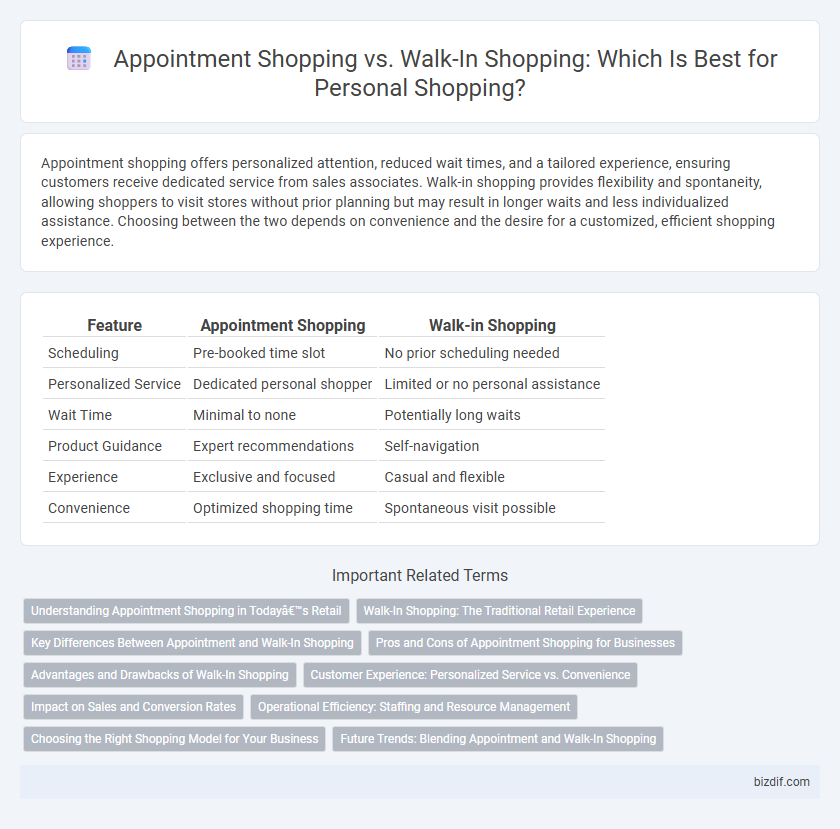Appointment shopping offers personalized attention, reduced wait times, and a tailored experience, ensuring customers receive dedicated service from sales associates. Walk-in shopping provides flexibility and spontaneity, allowing shoppers to visit stores without prior planning but may result in longer waits and less individualized assistance. Choosing between the two depends on convenience and the desire for a customized, efficient shopping experience.
Table of Comparison
| Feature | Appointment Shopping | Walk-in Shopping |
|---|---|---|
| Scheduling | Pre-booked time slot | No prior scheduling needed |
| Personalized Service | Dedicated personal shopper | Limited or no personal assistance |
| Wait Time | Minimal to none | Potentially long waits |
| Product Guidance | Expert recommendations | Self-navigation |
| Experience | Exclusive and focused | Casual and flexible |
| Convenience | Optimized shopping time | Spontaneous visit possible |
Understanding Appointment Shopping in Today’s Retail
Appointment shopping offers a personalized retail experience that allows customers to schedule dedicated time slots with sales associates, ensuring focused attention and minimized wait times. This approach enhances customer satisfaction by providing tailored product recommendations and a more relaxed, private environment compared to traditional walk-in shopping. Retailers leverage appointment shopping to improve inventory management and create stronger client relationships through customized service.
Walk-In Shopping: The Traditional Retail Experience
Walk-in shopping offers the traditional retail experience where customers freely browse stores without prior scheduling, allowing spontaneous purchases and immediate product access. This method provides the tactile advantage of physically examining merchandise, enhancing decision-making through direct interaction. Retailers benefit from walk-in traffic by attracting diverse customer segments and leveraging impulse buying opportunities.
Key Differences Between Appointment and Walk-In Shopping
Appointment shopping offers personalized service with scheduled times, reducing wait times and ensuring dedicated attention from staff. Walk-in shopping provides flexibility and spontaneity but may involve longer wait times and limited personalized assistance. Key differences lie in the level of customization, time management, and convenience tailored to customer preferences.
Pros and Cons of Appointment Shopping for Businesses
Appointment shopping allows businesses to offer personalized, one-on-one customer experiences, enhancing customer satisfaction and increasing the likelihood of sales. It helps manage store traffic efficiently, reducing overcrowding and improving service quality during high-demand periods. However, appointment shopping may limit spontaneous purchases and require additional scheduling resources, potentially reducing overall foot traffic and sales opportunities.
Advantages and Drawbacks of Walk-In Shopping
Walk-in shopping offers immediate access to stores without the need for prior scheduling, providing flexibility for spontaneous purchases and quick errands. However, it can lead to longer wait times, limited personalized service, and potential overcrowding during peak hours, which might diminish the overall shopping experience. The lack of guaranteed availability for specific products or assistance contrasts with the tailored, dedicated attention found in appointment shopping.
Customer Experience: Personalized Service vs. Convenience
Appointment shopping provides a personalized service where customers receive dedicated attention tailored to their preferences, enhancing satisfaction and product selection. Walk-in shopping offers the convenience of immediate access without scheduling, appealing to spontaneous buyers and those with flexible time. Both methods impact customer experience differently, balancing personalized interaction against accessibility.
Impact on Sales and Conversion Rates
Appointment shopping significantly boosts sales and conversion rates by offering personalized, dedicated time with sales associates, leading to higher customer satisfaction and increased purchase likelihood. Walk-in shopping, while convenient for casual buyers, often results in lower conversion due to limited staff attention and less tailored service. Retailers reporting appointment-based shopping experience up to a 30% increase in average transaction value compared to walk-in customers.
Operational Efficiency: Staffing and Resource Management
Appointment shopping streamlines operational efficiency by enabling precise staffing and resource allocation tailored to expected customer volume, reducing wait times and enhancing personalized service. Walk-in shopping demands flexible staffing strategies to manage unpredictable customer flow, which can lead to overstaffing or understaffing and affect service quality. Optimizing appointment scheduling systems allows retailers to balance labor costs while maintaining high service standards and smooth store operations.
Choosing the Right Shopping Model for Your Business
Appointment shopping provides personalized service by scheduling dedicated time slots, enhancing customer experience and boosting sales conversion rates. Walk-in shopping offers flexibility and accessibility, catering to spontaneous buyers and larger customer volumes. Businesses must evaluate customer preferences, operational capacity, and sales goals to determine the optimal shopping model that maximizes engagement and revenue.
Future Trends: Blending Appointment and Walk-In Shopping
Future trends in personal shopping reveal a seamless integration between appointment shopping and walk-in experiences, driven by consumer demand for greater flexibility and personalization. Retailers are leveraging AI-powered scheduling tools and real-time inventory updates to create hybrid models that optimize time efficiency while maintaining tailored service. This fusion enhances customer satisfaction by balancing the convenience of spontaneous visits with the curated engagement of pre-booked appointments.
Appointment shopping vs Walk-in shopping Infographic

 bizdif.com
bizdif.com